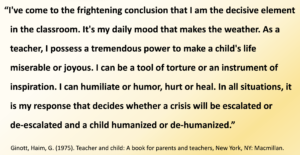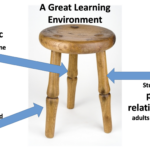Our Classroom Walls
This article appeared in the Responsive Classroom Newsletter: November 2015 (https://www.responsiveclassroom.org/article/our-classroom-walls)
During the school day we spend most of our time in our classroom and so do twenty to thirty students (give or take a few!). Many of us feel that our classroom is not complete until it is covered with colorful displays brightly shouting what our classroom hopes to be:
Rules! Library! Math Area! Aa Bb Cc…
We adorn bulletin boards with cloth and staples; we spend hours stapling, pasting, and laminating in order to cover our walls with things that we hope will enhance our students’ experience.
But is this the best approach? Take a look at your classroom walls and displays. What do they say about you, your relationship with your class, and your view of teaching? Are your students guests in your room, or does the classroom feel like a space you share with them? Do the walls and displays show what you think and believe . . . or do they show what your students know, think, and wonder about?
To create a classroom space that says to students, “This is your classroom!” displays should consist primarily of the children’s work, rather than teacher-made or store-bought pieces, no matter how beautiful those pieces might be. Why?
- When teachers create or purchase most of the classroom displays, the classroom says a lot about the teacher, but not as much about the students as it should.
- Making elaborate displays can be costly—both financially and in teacher time and energy. Creating a space with fewer distractions— and that students can feel ownership of— simplifies teachers’ lives.
Here are some tips as you decorate your classroom walls throughout the school year:
- Make sure the most of the classroom displays are works created by students. Roughly, what percentage of classroom displays includes work done in whole or in part by students? What percentage is devoted to posters or materials that were purchased or inherited?
- Students should decide which pieces of work to display. In taking on responsibility for displays, students have an opportunity to learn and practice important social and academic skills. When children choose work for displays, they learn to reflect on their work.
- Students should help to set up displays. Setting up a display allows children to develop their creativity and to practice skills of measuring, cutting, using tools, and writing. Maintaining displays gives an opportunity for children to develop organizational and decision-making skills. All aspects of creating and maintaining displays allow children to take responsibility for an important part of the classroom life.
- Displays should have a meaningful connection to the current curriculum. They should be effective tools for teaching and learning. This is particularly important as the holiday season approaches. Although there’s nothing wrong with seasonal displays, the material on display should go beyond simply marking the holiday. Instead the information should connect with, emerge from, and expand students’ knowledge about topics being studied.
- Keep displays fresh, useful, and uncluttered. Once the class finishes their work on a particular topic, displays should come down to make room for the next one. A study conducted by Carnegie Mellon University placed students in a brightly decorated classroom and one with nothing on the walls. They were given lessons in both environments and then a short assessment. They were also videotaped for the amount of time they looked away from the teacher. You may not be surprised to hear that the students in the decorated room looked away from the teacher more often (38% of time vs. 28% of time) and scored lower on the assessment (42% vs. 55%) (Fisher et al, 2014).
- At least one display should reflect the efforts of everyone in the class. These displays affirm each child’s sense of belonging and have a powerful effect on creating community. For example, many classrooms have a permanent display of students’ “hopes and dreams” for the year.
- Displays should be easily visible. Are the displays or charts at students’ eye level? How else does the decor of the classroom take into account the children’s developmental needs?
Our classroom space belongs to everyone. A classroom filled with the work of children is a delight to be in and sends a message to students that their work and their learning are important.
Article Contributors: Mike Anderson, Gina Castelli, Marlynn K. Clayton, and Margaret Berry Wilson




